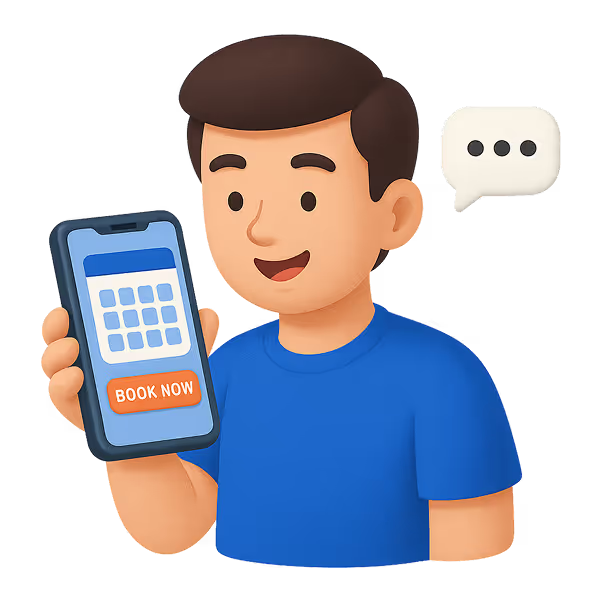
When you hire a babysitter, you're not just trusting them with your child. Hiring a babysitter also means that you’re inviting them into your home and daily routine. Thus, for a smoother experience, it’s important to clearly communicate your house rules from the beginning. Whether it’s about snack time, nap schedules, screen use, or playtime expectations, giving your sitter a clear guide helps your child feel secure and ensures the sitter can do their job confidently.
9 Ways to Communicate House Rules to a Babysitter
Start With an Introduction to Your Family
First, introduce your family to the babysitter. Let the babysitter know your children's names, ages, and a little about their personalities. Is your toddler shy at first but energetic once comfortable? Do your kids often need more time to warm up with new people? This kind of insight helps the sitter build a connection with your kids and better respond to their needs.
Arrange a quick meet-and-greet before the sitter’s first day, if possible. This gives the sitter a chance to observe how your household flows and ask questions. It also helps your children feel more at ease, especially if they are anxious about being left with someone new.
Provide Daily Routine List
Next, it is also important to make sure your babysitter understands your family’s daily rhythm. This includes wake-up times, meal and snack schedules, nap or quiet time, play routines, and bedtime. For example, let the sitter know the exact time of your children's nap time, how you usually settle them down, and what comfort items they need. If your children usually watch a cartoon before dinner, explain the time limit and preferred shows. The more details you give, the better the sitter can mirror your normal routine, keeping things consistent for your children.
Let Sitter Know About Snack Rules
Food is one of the most important aspects of childcare. Let your babysitter know what snacks are allowed, and how often your child can have them, and most importantly, make sure your babysitter is informed if your child has food allergies or sensitivities they should watch for.
Some parents prefer healthier snacks like fruit or yogurt, while others may allow occasional treats. If you have rules like no sugary snacks and beverages, make those guidelines crystal clear.
Also, tell the sitter where snacks are stored, which ones your child likes best, and how much they can have. For younger kids, snacks might be tied to specific cues like post-nap or pre-playtime. Giving your babysitter these clues can make snack time easier and prevent tantrums caused by hunger or miscommunication.
Set Boundaries Around Screen Time
Different families have different approaches to screens, and this is an area where expectations should be very clear. Some families avoid screens altogether during babysitting hours, while others allow a short cartoon before dinner. Let the babysitter know your stance and the reasoning behind it so they can follow your rules without conflict.
Talk About Discipline and Behavior Management
Every family has their approach to discipline. Whether you use time-outs, gentle redirection, or positive reinforcement, your babysitter should know what you expect when your child misbehaves. Tell them what behaviors to watch for, how you normally address them, and what boundaries are non-negotiable. This helps your babysitter stay consistent with your parenting style and keeps your child from getting confused or testing limits.
Inform About Nap Times Schedule
Nap time can be one of the biggest challenges for babysitters, especially if your child struggles to fall asleep without a parent. Help them out by explaining what usually works for your child. Does your toddler need a lullaby, a book, or white noise? Will they need a pacifier for sleep? All of this little tidbit information is important to share with the babysitter.
Explain your expectations for how long the nap should be and what the babysitter should do if your child refuses to sleep. It’s also helpful to let the sitter know if it’s okay to contact you during nap time, if they’re unsure what to do. That way, they don’t have to guess or make decisions you wouldn’t support.
House Rules for the Babysitter
Your house rules aren’t just for your kids; they apply to babysitters, too. It’s perfectly acceptable to set boundaries around personal phone use, visitors, or areas of the home that are off-limits. For example, let them know if you prefer them not to use their phone except in emergencies, or if they should only use the guest bathroom and not your master bathroom. Explain any expectations about cleaning up after meals or playtime, and whether they can eat your food.
You should also communicate your rules about social media use. It's important to specify if you don’t want photos or videos of your child to be shared on the sitter's social media. This will help protect your child's privacy and keep them safe online.
Don’t hesitate to create house rules, as these guidelines aren’t about being strict—they help ensure everyone respects each other’s space and privacy.
Communicate Openly
The best relationships between parents and babysitters are built on trust and communication. Let your sitter know they can reach out to you if they’re unsure about anything. Encourage them to give you updates about how the day went, especially if some challenges or things that went particularly well.
After the first few sittings, have a quick check-in to ask how things are going. Are the routines working? Does your child respond well to them? Are there any areas where the sitter feels unsure? These conversations help fine-tune the caregiving experience and ensure your child is happy and safe.
Have a Written Brief On Hand
Even if you’ve gone over everything verbally, it is still helpful to leave a written version of your rules and routines for the babysitter. This can include emergency contact numbers, allergy information, favorite activities, screen time rules, and the bedtime routine. That way, if the sitter forgets anything or needs to double-check a detail, they have a reference. Having a written guide takes the pressure off both you and the sitter.
Final Thoughts
When a babysitter understands your expectations and feels supported, they can focus on creating a nurturing and fun environment for your child. Clear communication about snack rules, nap time, discipline, and house guidelines isn’t about micromanaging—it’s about setting everyone up for success. Your child will feel more secure, your babysitter will feel more confident, and you’ll have peace of mind while you’re away.
Looking for a trusted babysitter in Singapore? Luce offers verified, affordable babysitters with flexible and hassle-free scheduling. With transparent rates and caregivers you can trust, Luce makes it easy to find the right match for your family’s needs.





















